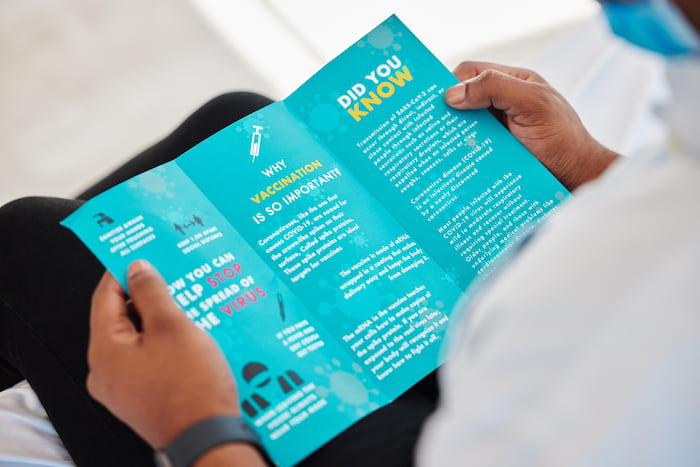Given the dominance of online platforms in this digital age, it’s easy to overlook the enduring relevance of traditional print materials. However, when it comes to patient education and awareness, print materials still hold a valuable position. They serve as tangible reminders, provide easy access to information, and can be especially beneficial in areas with limited internet connectivity.
Despite the rise of digital methods, there’s still a strong emphasis on the importance of high-quality print materials, as highlighted by companies like First Colour. When designed correctly, these materials can significantly aid in patient understanding, retention, and compliance with medical guidelines.
Below is a list of effective print materials for patient education and awareness.
Key Features Of Effective Print Materials
Before delving into the different types of print materials, it’s important to get familiar with their key features. These include:
– Readability: The primary purpose of patient education materials is to convey information. Therefore, using clear fonts, appropriate sizes, and structured layouts is crucial. Bullet points, subheadings, and concise paragraphs can also make the content more digestible.
– Engaging Design: An appealing visual layout with relevant images and illustrations can draw attention and make complex medical topics more understandable. Using color, proper contrast, and a balanced composition can help enhance the material’s overall effectiveness.
– Durability: Print materials in medical settings often see frequent handling. Therefore, use durable paper, lamination, or other protective coatings to extend the lifespan of the material and ensure that it remains available to patients for extended periods.
By incorporating these key features, healthcare providers can design impactful print materials.

The Different Types Of Print Materials For Patient Education
Now, let’s explore the various types of print materials commonly used in patient education and awareness. Print materials have been instrumental in conveying critical health information to patients. By providing tangible resources that they can refer to at their convenience, these materials can reinforce verbal instructions, help clarify doubts, and promote adherence to medical advice.
Below are the different types of print materials used for patient education and awareness:
1- Brochures
These are concise, folded pamphlets that offer snapshots of vital information. Brochures are great for presenting summarized details about a specific condition, medication, procedure, or health practice. Due to their compact nature, they can be easily distributed during medical appointments or health fairs. Also, the brochures’ brevity ensures that key points are highlighted, making it easier for patients to grasp the essentials quickly.
2- Posters
These are large visual aids designed for display in clinics, hospitals, or health centers. Posters often depict medical diagrams, preventive measures, or general health guidelines. They serve as constant reminders and are especially effective in waiting rooms where patients have time to absorb the information. Lastly, their visual appeal grabs attention, and the concise information can be consumed in a short span, even from a distance.
3- Booklets and Manuals
These are multi-page publications that delve deep into subjects. Booklets and manuals are used when patients require comprehensive information on their condition, treatment plan, or post-operative care. They can encompass everything from dietary guidelines to physiotherapy exercises. They also allow for in-depth exploration by ensuring that patients and their families have a thorough understanding and a resource to refer back to.
4- Fact Sheets
These are single-page documents that focus on key information. Fact sheets are ideal for conveying essential facts about diseases, medications, or post-treatment care. They’re straightforward and are often used as quick reference guides. Their simplicity also ensures that patients can quickly scan and absorb the most critical details.
5- Flashcards
These are small cards with information on one side and corresponding visuals or answers on the other. Flashcards can be used for quick revision, testing knowledge, or promoting active engagement with the material. They might highlight symptoms, medication dosages, or even medical terminology. They also promote active recall, which can improve the retention of information.
6- Newsletters
These periodic publications are often distributed monthly or quarterly. Newsletters keep patients updated about the latest health news, innovations in treatments, or even upcoming health-related events. They can also spotlight patient success stories or offer seasonal health tips. By receiving regular information from newsletters, patients feel more engaged and connected with their healthcare providers.
7- Infographics
These are visual representations of information, data, or knowledge. Infographics are perfect for explaining complex medical processes or statistics in a simplified manner. They combine graphics with minimal text to make data more understandable. Their visually appealing nature ensures high engagement, and they can simplify complex topics, making them easier to understand.
8- Worksheets and Journals
These are interactive materials that patients can fill out. Worksheets might guide patients through exercises or track symptoms. Journals can help patients record their progress, side effects, or daily health routines. These print materials encourage active participation, allowing patients to take charge of their health and providing healthcare providers with tangible feedback.
These various print materials available for patient education can ensure that healthcare professionals can cater to diverse learning styles and information needs. By selecting the appropriate print medium and ensuring its design and content are top-notch, healthcare providers can significantly enhance patient understanding and outcomes.
Conclusion
While the digital revolution continues to reshape various sectors, the realm of patient education and awareness still benefits immensely from traditional print materials. By keeping the information mentioned above in mind, healthcare providers can identify the various print materials for their education and awareness campaigns. The materials’ tactile nature, combined with effective design and content strategies, can ensure they remain a cornerstone in educating and informing patients about their health.
Read Also
- How to Drive Growth Through Customer Centricity in HealthcareThe world of healthcare is changing in big ways. Consumers are now stepping up and taking charge of their health journeys. This change is happening now for important reasons. The U.S. health and wellness market is huge, projected to be over $6 trillion in 2025. This growth is fueled by rising out-of-pocket costs and more… Read more: How to Drive Growth Through Customer Centricity in Healthcare
- Maximizing Digital Reach for Podiatry Clinics in Local HealthcareMaximizing Digital Reach for Podiatry Clinics in Local Healthcare As the healthcare industry evolves, mobile marketing becomes indispensable for practitioners. Podiatry clinics, focusing on foot and ankle care, must adapt to digital strategies to engage patients effectively. Implementing tailored SEO practices is crucial for these clinics to thrive in an increasingly competitive market. Digital marketing… Read more: Maximizing Digital Reach for Podiatry Clinics in Local Healthcare
- Leveraging Virtual Medical Assistants to Maximize Operational Efficiency in HealthcareIn the increasingly complex and fast-paced world of healthcare, operational efficiency is critical. Doctors and healthcare administrators are faced with numerous challenges, from managing patient scheduling and medical billing to adhering to stringent regulatory compliance and insurance claims processing. These tasks, while essential, often divert time and resources away from the core mission of providing… Read more: Leveraging Virtual Medical Assistants to Maximize Operational Efficiency in Healthcare
- Optimizing CT Protocols: The Hidden Key to Efficiency and Cost Savings in RadiologyIntroduction: Why CT Protocol Optimization Matters Computed Tomography (CT) is a cornerstone of modern diagnostic imaging, providing critical information across nearly every medical specialty. However, maximizing the value of CT — both clinically and financially — requires more than just advanced hardware. The real secret lies in the optimization of CT protocols. When CT protocols… Read more: Optimizing CT Protocols: The Hidden Key to Efficiency and Cost Savings in Radiology
- Hospital Discharge Accuracy Improves With Daily Advisor InvolvementThe hospital discharge process has a big effect on patient recovery, hospital efficiency, and finances. It requires careful planning and clear communication between team members to make sure patients get the right care when they leave the hospital. Having physician advisors involved at this stage can improve the discharge process by spotting problems that need… Read more: Hospital Discharge Accuracy Improves With Daily Advisor Involvement






